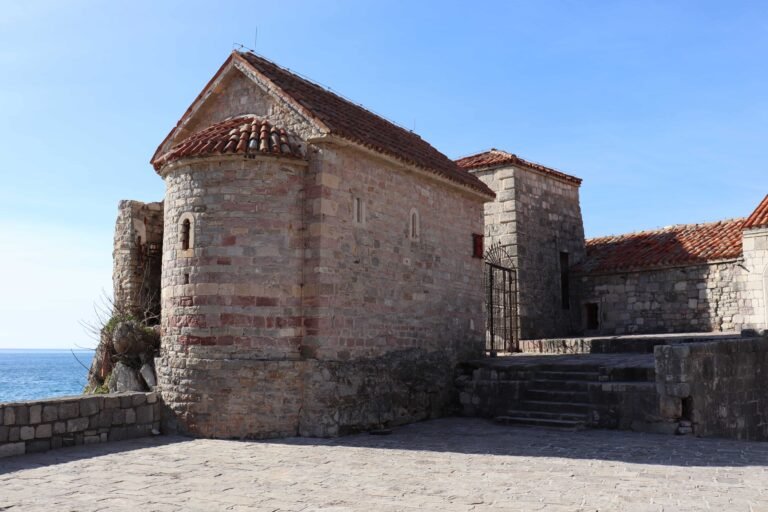O antičkom periodu Budve, kao i boravku Grka i Rimljana na njenim teritorijama, živopisno svjedoči antička nekropola, koja se nalazila u blizini Starog grada. Nekropola je slučajno otkrivena prilikom iskopavanja temelja za hotel “Avala”, kada je tokom radova u periodu od 1936. do 1938. otkriven veliki dio antičkog groblja. Nakon sistemastkih istraživanja koja su otpočeta 1952, pretpostavilo se da najstariji grobovi pripadaju helenističkoj eri i počecima IV vijeka stare ere, dok su najmlađi datirani u kraj V i početak VI vijeka nove ere. Nekropola je čuvala veliki broj pravougaonih grobnica i nadgrobnih ploča oblikovanih u skladu sa obredima i tradicijama naroda koji su ih gradili.
Helenistčke grobnice ističu se po kamenim sarkofazima za sahranjivanje preminulih, kao i votivnim darovima – grobnim prilozima. Za rimske obrede sahranjivanja bilo je tipično spaljivanje, te se za ovaj period ugalvnom datira veliki broj grobova sa kamenim urnama. Uz urne pokojnika polagani su i različiti predmeti od keramike i stakla, ali i novčići na osnovu kojih je moguće okvirno odrediti vrijeme sahranjivanja pokojnika. Grobnice složenijih arhitektonskih rješenja svjedoče o romanizaciji stanovništva Budve i njenoj nesumnjivoj ekonomskoj snazi tokom I i II vijeka nove ere.
Ritual spaljivanja pokojnika će na početku III vijeka postepeno biti zamijenjen inhumacijom. Grobnice iz V i VI vijeka nove ere odlikuju se skromnom obradom koja svjedoči o postepenom osiromašenju i degradaciji stanovništva tokom vizantijske prevlasti.
Većina predmeta koji su otkriveni u toku istraživanja, bili su oštećeni, uništeni ili premješteni. Samo manji dio bogatog grobnog materijala očuvan je prema arheološkim normama i danas se nalazi u muzejima u Budvi, Cetinju, Zagrebu, Splitu, Beogradu, ali i u privatnim kolekcijama. Ono što se danas može vidjeti ispred ulaza u Stari grad jeste rimski cipus, nadgrobni spomenik, dislociran i prezentovan u znak reminiscencije na nekropolu i antičku prošlost Budve.
Fragments of the Ancient Necropolis, 1st – 2nd century
The Ancient necropolis, which used to be located near the Old Town, vividly testifies to the ancient period of Budva, as well as the time when Greeks and Romans were inhabiting these territories. The necropolis was accidentally discovered during the excavations for the foundation of the ‘Avala’ hotel when during the works in the period from 1936 to 1938, a large part of the ancient cemetery was discovered. After systematic research which began in 1952, it was assumed that the oldest graves belong to the Hellenistic era and the beginning of the 4th century BC, while the youngest ones are dated to the end of the 5th and the beginning of the 6th century AD. The necropolis kept a large number of rectangular tombstones shaped following the rites and traditions of the people who built them.
Hellenistic tombs stand out for their stone sarcophagi for burying the deceased as well as votive offerings for religious purposes. Cremation was typical for Roman burial rites, and a large number of graves with stone urns are mostly dated to this period. Along with the urns of the deceased, various objects made of ceramics and glass were laid in the graves, as well as coins which help us roughly date the time of burials. Tombs with more complex architectural solutions bear witness to the Romanization of the population of Budva and its undoubted economic strengths during the 1st and 2nd centuries AD.
At the beginning of the 3rd century, the ritual of burning the deceased will gradually be replaced by inhumation. The tombs from the 6th century AD are distinguished by their modest decoration. This was due to the gradual impoverishment and degradation of the population during Byzantine rule.
Most of the items that were excavated during the research were damaged, destroyed or relocated. Only a small part of the rich burial material has been preserved according to the archaeological standards and can be found in museums in Budva, Cetinje, Zagreb, Split and Belgrade, but also in private collections. What is seen today in front of the entrance to the Old Towns is a Roman cippus, a tombstone, dislocated and presented as a reminder of the necropolis and the ancient past of Budva.





